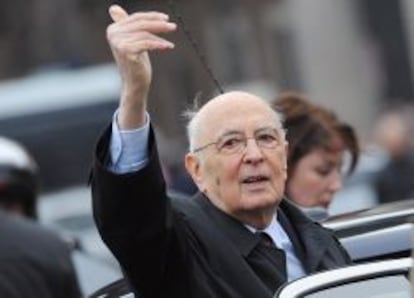Giorgio Napolitano, former Italian president, has died at 98
Italy’s presidential palace says the first former Communist to rise to Italy’s presidency, has died. Napolitano was also the first person to be elected twice to the presidency

Giorgio Napolitano, the first former Communist to rise to Italy’s presidency and the first person to be elected twice to the mostly ceremonial post, died on Friday, the presidential palace said. He was 98.
A statement issued Friday night by the presidential palace confirmed Italian news reports of the death of Napolitano, who had been ailing in a Rome hospital for weeks.
The current president, Sergio Mattarella, in a message hailed his predecessor as head of state, saying that Napolitano’s life “mirrored a large part of (Italy’s) history in the second half of the 20th century, with its dramas, its complexity, its goals, its hopes.”
As a prominent member of what had long been the largest Communist party in the West, Napolitano had advocated positions that often veered from party orthodoxy. He sought dialogue with Italian and European socialists to end his party’s isolation, and he was an early backer of European integration.
Turin daily La Stampa once wrote of Napolitano: “He was the least communist Communist that the party ever enlisted.”
In a condolence telegram to Napolitano’s widow, Clio, Pope Francis said the late president “showed great gifts of intellect and sincere passion for Italian political life as well as strong interest for the fates of nations.”
The pontiff, who is on a pilgrimage to France, noted he had had personal meetings with Napolitano, “during which I appreciated his humanity and long-range vision in assuming with rectitude important choices, especially in delicate moments for the life of the country.”
During the first Gulf War, Napolitano broke with the position of the leader of the Italian Communist Party to oppose the withdrawal of Italy’s tiny contingent.
That amounted to a radical evolution for a Communist politician, who at the time of the 1956 Soviet invasion of Hungary had hailed the suppression as necessary. Ultimately, his political reputation was shaped by his reformist views.
A former U.S. ambassador to Italy, Richard Gardner, in comments to The Associated Press in 2006, when Napolitano was first elected to be head of state, called him “a true believer in democracy, a friend to the United States.” As ambassador, Gardner had helped arrange secret meetings with Napolitano at a time when any public meeting would have been seen as embarrassing for Italian Communists as well as U.S. politicians.
After the fall of the Berlin Wall in 1989, Napolitano was among the staunchest supporters of his party’s reform path, which would eventually lead to changing its name and dropping the hammer-and-sickle symbol.
Premier Giorgia Meloni, whose far-right party is at the opposite end of the political spectrum of the late president, expressed condolences in the name of her government.
Like many other future politicians of his generation, Napolitano fought against the Italian Fascists and Nazi occupiers during World War II. When the war ended, he joined the Communist Party, and in 1953, he was elected to Parliament, an office he would hold for 10 straight legislatures.
In 1989, he went to the United States with the party secretary for the first-ever visit by a Italian Communist leader.
While the presidential role is mostly ceremonial, the head of state can send Parliament packing sooner than its normal five-year term if it is hopelessly squabbling, a not-rare occurrence in Italy’s long history of short-lived governments.
The president also taps someone to attempt to form a new government and can reject some of the premier’s Cabinet choices or refuse to sign legislation as a way to encourage Parliament to improve a law.
Supposed to be above the political fray, Italy’s president also can serve as a sort of moral compass for the country and a guardian of the values laid out in Italy’s post-war Constitution.
During his long career, Napolitano also served as speaker of Parliament’s lower Chamber of Deputies and for five years as a lawmaker in the European Parliament.
In 2005, his predecessor in the Quirinal palace, Carlo Azeglio Ciampi, conferred on him one of Italy’s greatest honors, making him a senator-for-life.
A year later, Parliament would make him president of Italy, the first former Communist — and so far the only one — to serve as head of state.
Admirers praised Napolitano’s balanced attitude and gentlemanly ways. He was sometimes dubbed “King Giorgio.” But critics pointed to what they saw as excessive caution.
Still, when at the end of his first, seven-year term as head of state, bickering lawmakers couldn’t reach consensus on his successor, he broke with tradition and agreed to be elected to a second term — with the proviso that he wouldn’t serve a full term due to advancing age. He was then 80.
In April 2013, Napolitano pardoned a U.S. Air Force colonel convicted in an Italian trial based on the U.S. extraordinary rendition practice that had resulted in a Muslim cleric being abducted from a street in Milan in 2003 and hustled off to Egypt where he was tortured, before eventually being released.
Napolitano said he granted the pardon in hopes of keeping U.S.-Italian relations strong, especially on security matters. The United States had considered the trial and convictions unprecedented because a U.S. military officer had been convicted for deeds committed on Italian territory.
Napolitano resigned in January 2015, paving the way for Mattarella, a former Christian Democrat, to be elected. Mattarella would go on to be himself twice elected to the presidency, again after renewed political gridlock in Parliament thwarted the election of a fresh candidate in 2022.
Beside his wife, whom he married in 1959, Napolitano is survived by two sons, Giovanni and Giulio.
Sign up for our weekly newsletter to get more English-language news coverage from EL PAÍS USA Edition
Tu suscripción se está usando en otro dispositivo
¿Quieres añadir otro usuario a tu suscripción?
Si continúas leyendo en este dispositivo, no se podrá leer en el otro.
FlechaTu suscripción se está usando en otro dispositivo y solo puedes acceder a EL PAÍS desde un dispositivo a la vez.
Si quieres compartir tu cuenta, cambia tu suscripción a la modalidad Premium, así podrás añadir otro usuario. Cada uno accederá con su propia cuenta de email, lo que os permitirá personalizar vuestra experiencia en EL PAÍS.
¿Tienes una suscripción de empresa? Accede aquí para contratar más cuentas.
En el caso de no saber quién está usando tu cuenta, te recomendamos cambiar tu contraseña aquí.
Si decides continuar compartiendo tu cuenta, este mensaje se mostrará en tu dispositivo y en el de la otra persona que está usando tu cuenta de forma indefinida, afectando a tu experiencia de lectura. Puedes consultar aquí los términos y condiciones de la suscripción digital.
More information
Archived In
Últimas noticias
‘Sleepless City’: The light of cinema illuminates Madrid’s Cañada Real shantytown
All the effects of gentrification in one corner of Mexico’s Colonia Roma
Palestinian reporter Youmna El Sayed: ‘My family told me I had to choose between being a journalist or a mother’
The new language of the workplace: Knowing how to ask AI questions is more important than using it
Most viewed
- The low-cost creative revolution: How technology is making art accessible to everyone
- Christian Louboutin: ‘Young people don’t want to be like their parents. And if their parents wear sneakers, they’re going to look for something else’
- US sanctions against jailed cartel leader ‘El Marro’ highlight Mexico’s lack of control over its prisons
- Liset Menéndez de la Prida, neuroscientist: ‘It’s not normal to constantly seek pleasure; it’s important to be bored, to be calm’
- ‘El Limones’ and the growing union disguise of Mexican organized crime










































